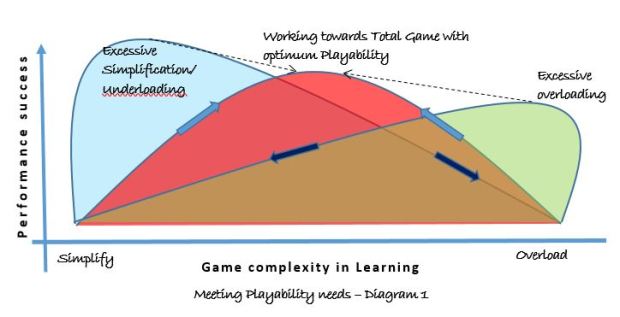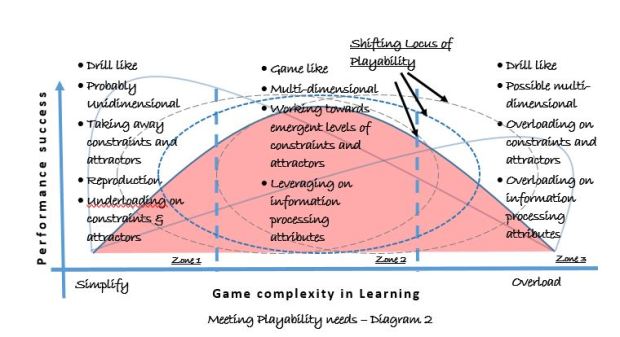Total Game – A theoretical ideal understanding position for the learner in all aspects of the game, usually with respect to the formal game as known universally. Our processes attempt to reach this utopia.
Playability – The environment we create for leaners that represents heading towards the Total Game. However, depending on leaner ability, the game scenario consists of elements that make it meaningful for learners and may not look like the formal known game.
What’s in a Game? – An attempt to codify aspects of a game through deconstruction without deconstructing! This process is done with realisation that movement solutions come with degrees of freedom which means the sum of the whole usually don’t add up to the whole.
Confusion – All the above:-)
Recently I have been thinking much about the different aspects of a typical lesson design in Physical education (PE) classes. These aspects include putting labels and descriptors to functional facets of a lesson design over its literal action/skill purpose. These functional facets include;
- elements of a lesson that can be manipulated for learning or understanding (modification of constraints),
- controlling distracting sources of the game environment (attractors that are part of the learner, task and environment),
- using teacher related influences (the quasi-constraint) like setting of instructions, facilitative behaviour, questioning, etc.
- must all be aligned to outcomes of PE!
All the above are with the aim of simplifying a learning scenario or overloading for fine tuning and enhancement of an action/skill (or a movement). At these point, I am risking a position that says all design basically boils down to these two destinations. The third neutral category is performance at its purest authentic existence, the actual game, which hypothetically lies in the middle of this discrete continuum (see Diagram 1). I say discrete because the complexity level of a design also has different sub elements with its own continuum (see Diagram 2). It is also possible for both simplifying and overloading to occur at the same time for different learners operating in the same theatre of performance. Over here, simplifying can be considered as underloading, e.g. in a 4 V 2 activity…the team of two is being overloaded and the other being underloaded. So, you might see the former performing in Zone 1 and the later in Zone 3 (see Diagram 1).
For me, when considering constraints and attractors, I consider functional task elements of;
- Passing (P)
- Scoring (S)
- Interception (I)
- Movement (referring to the act of getting into position/in-preparation for the above) (M).
Again, the above are focusing on the functional aspects of the learning action/skill that is intended for teaching. This codifying of lesson design allows also calibration of activity gameness (working towards the Total Game – where all knowledge demonstrated by learner of a game situation is unpinned by understanding) to meet the needs of wanting to learn via experience in an authentic environment, an important underpinning for approaches like Teaching Games for Understanding (TGfU) and Constraint Led Approach (CLA). The PSIM scaffolding also allows me to design according to Playability, a concept for me which reflects making every learning experience about a learner meeting his/her needs of wanting to exist in a game environment that meets their cognitive and affective needs for recreational movement. All game centred and learner centred proponents will talk about this in some way and my attempt is to make it very primarily deliberate in lesson design. (I received laughter from my students when I first mentioned Playability to my class after declaring I made the word up to reflect a learning scenario I need to offer them – it was very unusual for them to not receive technique based instructions primarily) This can partially explain the concept of the Joy of Learning or Play that comes about when on the ground practices intersects with leaner needs and ability.
Above or below the PSIM, underlay or overlay, will be the more common preference to look at defence and offensive objectives of game teaching with direct references to techniques needed. When it comes to an overall approach of reproduction learning, I can imagine a teacher wanting to get straight to the crunch by being very specific what they want learners to replicate. This can be seen many times when technique directed drills, versus zero set pieces, detailed instructions focusing on internal cues, etc. are emphasised on to get students moving immediately in the desired manner. Both teacher and learner looks very busy! (Assumption: Technique centred practises (solutions that are specific) are subsets of movement solutions (solutions that adapt with degrees of freedom) that are the objectives of game teaching. Not the other way around.)


The diagrams above sort of encapsulate a portion of what I have always been trying to achieve (key: trying!). Recently in some discussions on social media, the topic on using simple words and ideas to help in conveying important knowledge is much appreciated by most. I call this ‘tell me in 10 minutes or move over!’ rule. The counter to this is the need to understand complexity in actions and environment as it is and not dumb it down to suit ease of implementation. I feel that it is important (and I have stated this quite a few times in my reflections) for a middle layer to make sense for the rest of practitioners at the very least. This middle layer can be curriculum leaders both on the ground and at policy development and implementation levels. Eventually such broad knowledge need to make sense to everyone and constantly on the mind in delivering learning opportunities in school.
In trying to sort out my own understanding of what a multi facet design process might entail visually, I use the diagrams above. The question I ask myself, using the need to describe as simply as possible without losing any important embellishments, is how to scaffold approach to design and evaluating with the best information that is available out there. Again, quite a bit of my reflections are based on this beginning theme of trying to understand popular scenarios in lesson and working backward, a very inductive to deductive flow of thinking. There are flaws to this way of thinking as there will be a tendency to believe personal experiences are universal, which are not.
Vygotsky’s (1978) Zone of Proximal Development (ZPD) suggest that a learner will need that push from a more knowledgeable teacher or peer to reach a level where successful performance is possible unaided. This involve identifying the appropriate learning zones (what to teach) where such progress can happen (how we teach). The key here is the differentiation and scaffolding needed for different learners in the appropriate independent learning scenarios and probably not a one-size-fits-all (in strategies and learning outcomes) situation which is very tempting for the over whelmed teacher with plenty of students and classes. What this well-known idea espouses is something very familiar to us, i.e. making it relevant and authentic for learners while creating good learning. In Diagram 2, I have added in a shifting Playability Locus that reflect influences of relevance for learners. I can imagine that this zone shifts with different level of learners, making everything we do so much aligned (to learning and objectives) when it falls within such locus. End of day, amidst all the fancy (self-declared) schematics shown, this shifting Playability Locus is perhaps what we most want to identify for learners, together with what we need to achieve for PE.
This independent (learner centred) learning scenario is set by the teacher and could be artificially modified. What this can potentially cause, if not used careful, is a unidimensional task outcome that does not commensurate the authentic learning environment we strive for (Zone 1 in Diagram 1 and 2 – outside of Playability Locus). One key example, from thinking about ZPD and what it effectively entails, that crops up in my mind, is the use of Information Technology (IT), i.e. video technology through smart devices, for learners to compare internal cues with established biomechanics of expert movers or with each other. If left at that, the assumption is that the technology is doing the teaching via comparison. The IT here is the ‘expert peer’ allowing students to compare performance cues of self to expected ones. While this might seem like a collaborative effort with peers and technology with minimal teacher influence, I will say that the learning task is too unidimensional for any good transferable knowledge to the next stage of learning, if this is indeed deemed as an effective first stage. Of course, there are many other considerations here, from the efficacy of task decomposition to learners need to process information efficiently. What this examples say to me is that we are constantly trying to find ZPDs but may inadvertently create a learning opportunity, a learning zone, that suites merely a successful fixed outcome (easier for assessment?) more than an authentic one needed for better learning, e.g. in the extreme ends of Zone 1 or 3 in Diagram 2 as compared to Zone 2. I guess my intention is to say that not only must all learning must eventually move towards the centre, Zone 2, but also aligned to what we suppose to teach. We all have our own scaffolding abilities to ensure that we reach our objectives and the above is just an attempt to put a personal understanding to paper.
Another example of learning zones that may have to be considered further for its place in a learning journey is the growing movement for Gamification, a lesson design process leveraging and acknowledging the success of computer/video games and its ability to attract users and keeping them on it. The idea is using elements of its discovery and target achieving effectiveness for PE. The potential for outcomes becomes very remarkable. I have seen incredibly elaborate and interesting lessons created based on this that really seems to capture learners’ attention. Its relevance to the learning process is clearly there but I worry about the overlapping needed relevance to the objectives of PE being sidestepped. With this in mind, I will add the need to qualify Playability as also making meaning for students in the appropriate PE direction. Anyway, I believe that a lot of what is used outside recreational movement fields as attractors rely heavily on primitive needs to find competence, autonomy and association, right up our alley!
One key direction for moving forward is to consider a learning environment with a broader Bourdieusian lens of looking at capital available (expertise available out there), habits (how the different stakeholders in the scene operate within their influence) and field (how different stakeholders in practise, research, academia, policy, etc. interact) might bring us closer to realising how the system can best close gap between theory and practise of the way we operate, taking into consideration what is available. A lot of our reflections are of our own habits (practises), neglecting the needed engagement of our own capital with that of what is available out there, i.e. social capital, expert capital, economic capital, etc. The whole synergistic need is made more difficult when the field operates neutral to a collaborative need. Even as I stubbornly pen down my thoughts, I am aware of the potential richness that could have been if I had put more effort in accessing a more synergistic network of theory and practice.
“Easier Said Than Done”, 2018, A Frustrated Teacher
2 comments